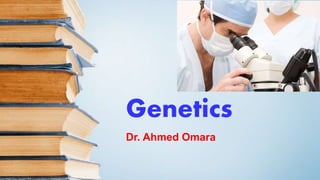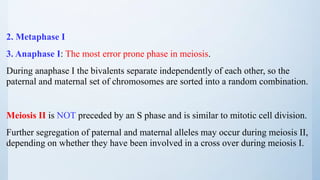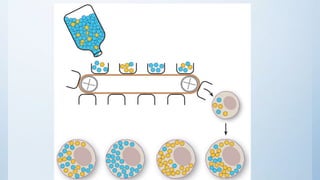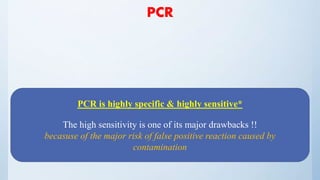Chromosomes contain DNA and play an important role in heredity. They are composed of chromatin, which contains DNA wrapped around histone proteins. Chromosomes replicate and separate precisely during cell division. Mutations in genes can cause genetic disorders and occur through changes in DNA sequence or chromosome structure. Gene expression involves transcription of DNA into RNA and translation of RNA into protein. The structure and behavior of chromosomes during mitosis and meiosis explains patterns of inheritance for autosomal and sex-linked traits.








![The structure of chromosomes
• Nucleotides: molecules, that when combined, form the structural units of DNA
and RNA. [RNA and DNA are polymers are created by long chains of nucleotides]
Composition of nucleotide:
Sugar molecule that is attached to a phosphate group and a nitrogen-containing base.
Linkage:
- 3'-5' phosphodiester bonds: link adjacent nucleotides in a polynucleotide chain
- Hydrogen bonds link pairs of bases](https://image.slidesharecdn.com/genetics-160307171741/85/Genetics-Ophthalmology-9-320.jpg)














































![X-linked recessive trait
The gene responsible for X-linked recessive traits is transmitted from an affected
male through all his daughters.
[The gene is never transmitted directly from father to son]
- Any son of a carrier female will have a 50% chance of inheriting the trait.](https://image.slidesharecdn.com/genetics-160307171741/85/Genetics-Ophthalmology-56-320.jpg)
























![Biochemical and molecular biological techniques
1. Restriction enzymes are endonucleases that cleave DNA on recognizing a
specific sequence.
[These sequences are between four and six base sequences long]*
Thus, a six basepair cutter will produce many fragments with an average length of 4 kb. Since
the genome is random, the fragment sizes will be variable about a mean.
2. Separation of these fragments by gel electrophoresis.
Fragments are loaded into wells in a tray of agarose gel, across which an electric
field is applied.
DNA is negatively charged will move towards the positive charge, with small
fragments migrating more quickly than large fragments.
Ultraviolet light is used to visualize DNA after staining with ethidium bromide.](https://image.slidesharecdn.com/genetics-160307171741/85/Genetics-Ophthalmology-81-320.jpg)


















